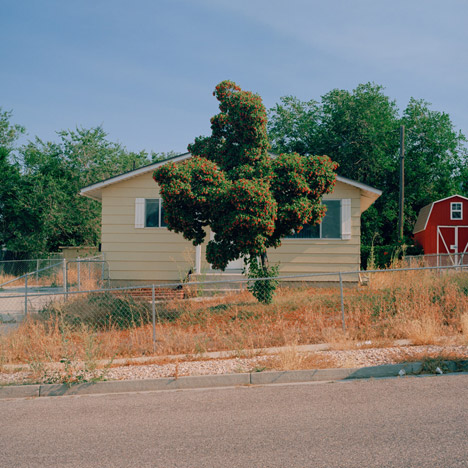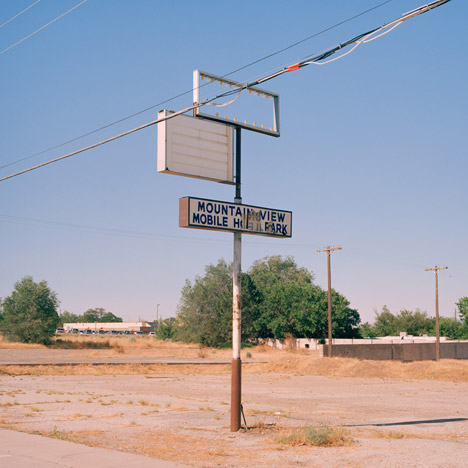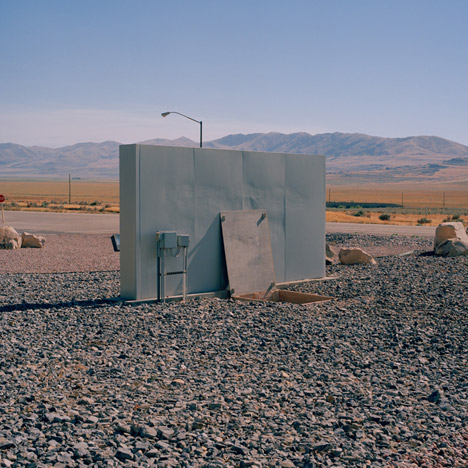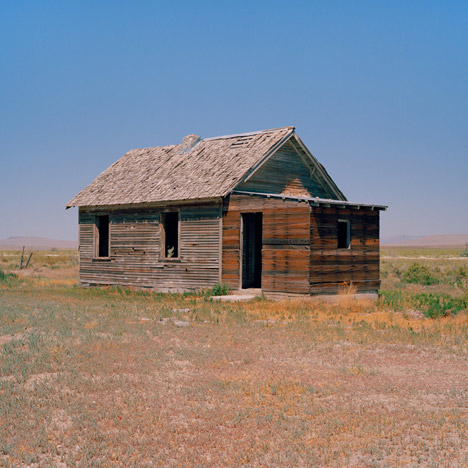Anthony Gerace photographs Utah's "completely empty" Box Elder County
Photo essay: intrigued about the American county that is home to Robert Smithson's Spiral Jetty, photographer Anthony Gerace visited Box Elder in Utah, only to find a "total sense of abandonment" (+ slideshow).
Named after a native tree, Box Elder County sits at the northern end of the Great Salt Lake. It boasts many points of historical and cultural interest, including the site of Smithson's 45-year-old artwork, which prompted London-based Gerace to fly out and shoot it.
His photographs present his findings – a sprawling urban landscape punctuated by abandoned houses, dilapidated signs and discarded rubbish.
"What I went there looking for was some positive proof that I could document that a multitude of voices can exist simultaneously somewhere – that ideas of manifest destiny, artistic integrity and environmentalism can cohabitate in an environment as intense as the Utahan desert," said Gerace. "What I found is they can't."
I originally learned about Box Elder through Robert Smithson's Spiral Jetty, a conceptual artwork in a pretty remote part of the Great Salt Lake in Utah. As I began to research the Jetty I became interested in the things that surrounded it. I became more interested when I found out that Box Elder (the county where the Jetty resides) is also home to the largest migratory bird refuge in the world and Promontory Point, where the final railway spike was lain for the first US transcontinental railway.

My thinking was that a place with so many contradictory histories – born from artistic, conservational, and manifest-destiny related urges – must have something special and unique about it and that, at the very least, the fact that such disparate ideals could coexist in the same place must've meant something significant; that it must have spoken to an alignment of the idealised "America" of legend and the reality of the United States today.
So I went in with a lot of positivity; a lot of my photography has been about places that were derelict or were teetering on the edge of inertia, and I thought that going somewhere that had so much positivity in it would make for a really interesting and ecstatic series of photographs. The reality of Box Elder was that it was completely empty. I'd looked at population records when I researched the place, so I knew that something like 0.05 per cent of the population of the US resided in Box Elder, and the county itself was huge. But what I didn't expect was what would be left over: a total sense of abandonment, compounded by the heat and the aridness, made all the more spiritually upsetting because of the things left behind.

There are a few towns in Box Elder but the majority of them can't really be considered that; the only place where (current) habitation is clearly evident is in Brigham City, and even Brigham only has a population of about 7,000. The rest of the county is full of abandoned houses, barns falling apart, outdated road signs, garbage everywhere, and a sense of ruin and desiccation. It's pretty fascinating as a place but not at all what I went in expecting.
What I went there looking for was some positive proof that I could document that a multitude of voices can exist simultaneously somewhere – that ideas of manifest destiny, artistic integrity and environmentalism can cohabitate in an environment as intense as the Utahan desert. What I found is they can't. Not because the will for coexistence isn't there, but because there's nothing there. And because the environment actively conspires to make living impossible, and that when that living becomes impossible the things left over just remain.

Smithson's vision for the Jetty was not what I'd originally thought it to be: I'd always viewed the Spiral Jetty as an attempt to confer with the sublime, but really, it's just a means of confronting, on a long timeline, the effect of entropy on objects, and that's what the series ended up being about. Box Elder is a place that's sliding slowly, but inexorably, into an entropic state, and the garbage and damage and weirdness that's there, and the absolutely beautiful but incredibly hostile and alien landscape surrounding it reinforces that.
I'd wanted to make the project an "ecstatic series", and what I meant by that was that I wanted to make it something that radiated the joy and insanity felt at being in a place so strange and different. I'd wanted to engage with the space in a way that provoked a sublime response, and in a lot of ways it did, although not at all in the way I'd envisioned.
My photographic work is primarily concerned with the lived experience, and a (hopefully) faithful documentation of that experience – though it's focused a lot on architecture and natural phenomena rather than people, the work is impossible without the outward urge guiding it. Box Elder ended up being a kind of terminus point; making the images forced me to confront a total entropy that I didn't know existed and therefore didn't know how to comprehend.
We drove out to the Spiral Jetty on our third day in the county, and like all the days preceding and all the days following, it was sunny, dry, and incredibly hot. Rozel Point, the part of the lake where the Jetty resides, is famous for a botched oil drilling operation, a piece of conceptual art, and a pink algae that's the only thing that can survive in the hypersalinated water. Perspective becomes a joke: everything is flat and white and the horizon bleeds into the sky. On that day, after walking the length of the jetty and photographing several dead birds, I began to walk toward the horizon. Utah was in the midst of a drought and that, coupled with the amount of salt around us, and the heat, made me thirsty and crazy and bug-eyed. I walked for thirty minutes until I reached water.

I took to describing the experience as "psyche shattering", which it was. I don't know if my images changed my perception of the place because the perception of the place that existed in my mind before going was one that I'd created for myself. But the architecture, such as it was, in the state it was in, and the landscape, certainly shifted my perception of the America I'd gone out hoping to find.